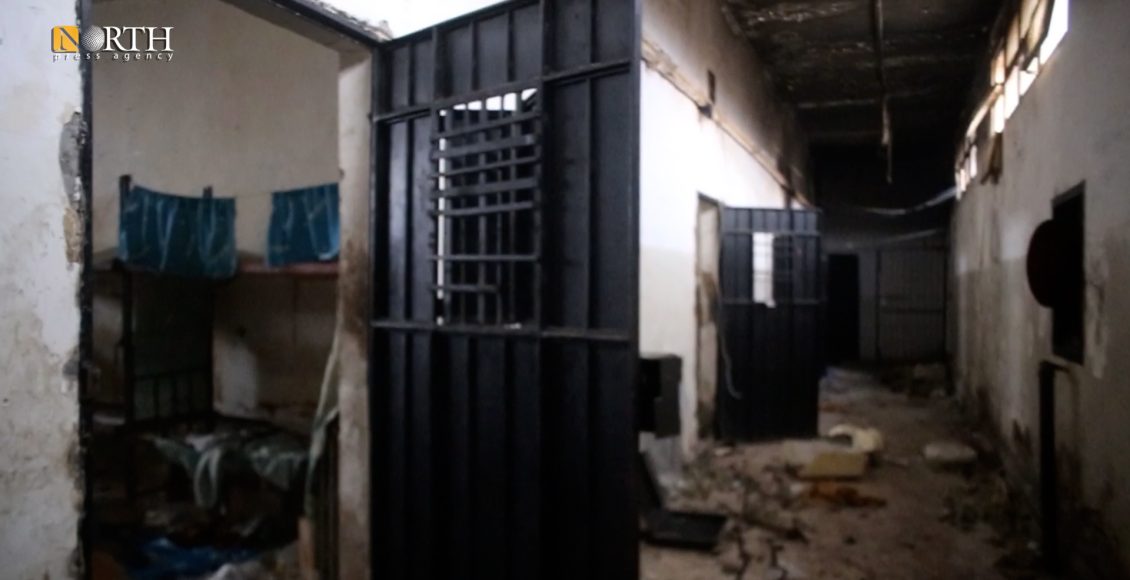Syrian prisoner’s harrowing tale of torture in Saydnaya Prison
By Khalaf Ma’o
DEIR EZ-ZOR, Syria (North Press) – In the dark basements of Syrian prisons, methods of torture extend far beyond physical pain, penetrating deep into the soul. The fallen al-Assad regime employed brutal techniques that forced detainees to live in constant fear, where no sound or movement escaped punishment.
Sixty-three-year-old Imad Hassan al-Taha, a former employee at the Water Directorate in the city of Deir ez-Zor in eastern Syria, recounts thousands of stories of injustice and torture endured over decades in the prisons of Bashar al-Assad’s ousted regime.
Fabricated confessions
Al-Taha tells North Press that he was arrested by the General Intelligence Directorate of the former Syrian regime on Sep. 28, 2011, at his workplace without an arrest warrant or any clear charge.
He explains that twenty Intelligence agents beat him until he lost consciousness, breaking his teeth in the process, as they relentlessly demanded his name and who his God was [A question asked by regime forces while beating people expecting the answer ‘Bashar’]. After about two months, he was transferred to Kafr Souseh prison in Damascus.
Five days later, he was moved to a solitary cell, where officials forced him to record a video reading a pre-prepared statement containing false accusations and unfamiliar names.
“They demanded that I read a fabricated confession asserting that I had been trained to kill,” he recalls. “I refused to comply. When they attempted to beat me again, they noticed how swollen my body was from previous torture—perhaps feeling a moment of pity, they ceased their assault.”
After spending another five days in Kafr Souseh, al-Taha was transferred to Qaboun neighborhood, stayed there one night, and then was moved to Saydnaya prison, known as the “human slaughterhouse.”
Established in 1987 and located 30 kilometers north of Damascus, Saydnaya was described by Amnesty International as the place “where the Syrian state quietly slaughters its own people.”
Cellars
Reflecting on his six-year ordeal in prisons under the former regime (two years in Saydnaya and four years in the central Suwayda prison), al-Taha recalls the sounds of torture that haunted the dark corridors.
“In Saydnaya, we could hear the screams of tortured women and even the cries of officers and soldiers undergoing the same fate,” he says.
He describes a particularly harrowing period of two months and ten days spent in dark, terrifying cellars, during which two residents of Abu Kamal lost their lives before his eyes due to the severe torture and maltreatment they endured.
Al-Taha also recounts the deep-seated fear among prisoners regarding family visits. “When my family came to visit me in Saydnaya for the first time, I wished they had not come,” he laments. “I was subjected to extreme torture, verbal abuse, and humiliation because they knew exactly where I was located.”
“I begged them never to visit again, knowing that each visit would only invite further torment. This was not the case just for me, but for every prisoner pleading to avoid additional suffering.”
After two years and a half in Saydnaya, thousands of detainees were eventually released and dispersed among prisons across Syria.
Al-Taha was transferred to a prison in Suwayda Governorate in southern Syria, where he spent four years before being released without any documents verifying his imprisonment—only a fingerprint or stamp on his hand, which served as his pass through checkpoints.
“When I was finally released after six and a half years, I hardly recognized my own family. My young daughter, who visited me in Saydnaya when she was three months old, was already in second grade. My son, then in fourth grade, had grown so tall I could hardly recognize him,” he points out.
“Even my friends, neighbors, and relatives greeted me, and I had to tell them that I needed time to remember them after witnessing what I endured in Saydnaya, in Suwayda, and in the other miserable detention centers of the regime.”
Iron-clad walls
Remembering his time in Saydnaya, from which he was released in 2017, al-Taha described the grim conditions of torture in the dark cellars.
“We could not see the guards because we covered our eyes, and we could not lower our hands when a guard entered. The guards would twist keys in the locks of those iron-clad prisons during meals or to administer physical punishment.”
He describes the meager rations, “Our food consisted of half a loaf of bread throughout the day, four olives for breakfast, and one egg divided among four people, which was cut using the thread of a blanket as a makeshift knife.”
The hunger was so severe that some prisoners resorted to grinding olives seeds to make a paste under the harsh conditions. “I could not do that because they had broken my front teeth during the torture,” he adds.
Al-Taha explains that Saydnaya was fortified in a terrifying manner, all interior walls and even the doors, were made of armored iron, up to sixty or seventy centimeters thick. “There was only a ceiling made of concrete or cement. They feared our escape so much that they reinforced every wall with hardened, armored iron.”

